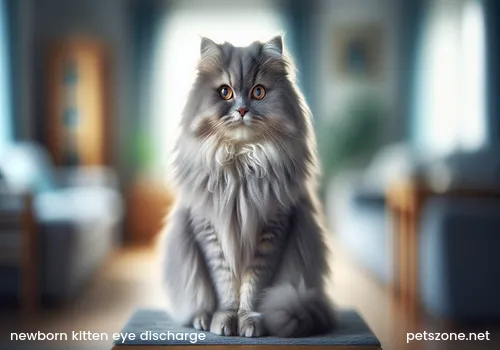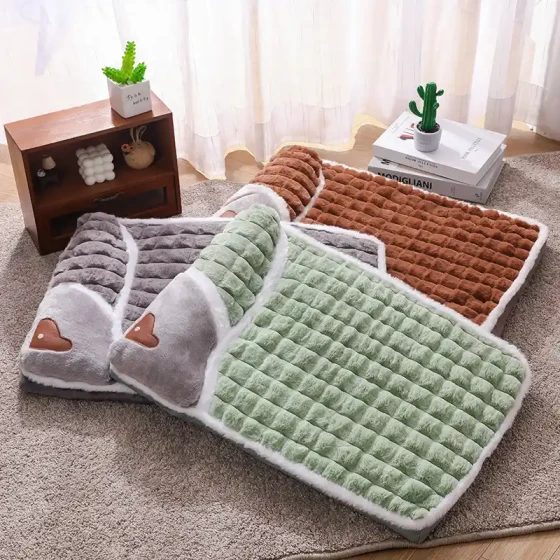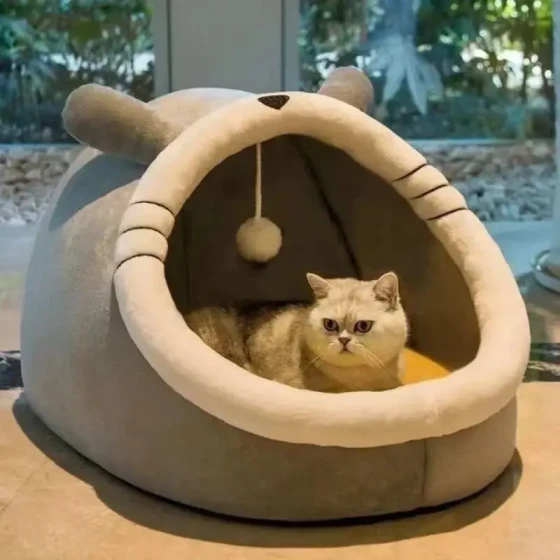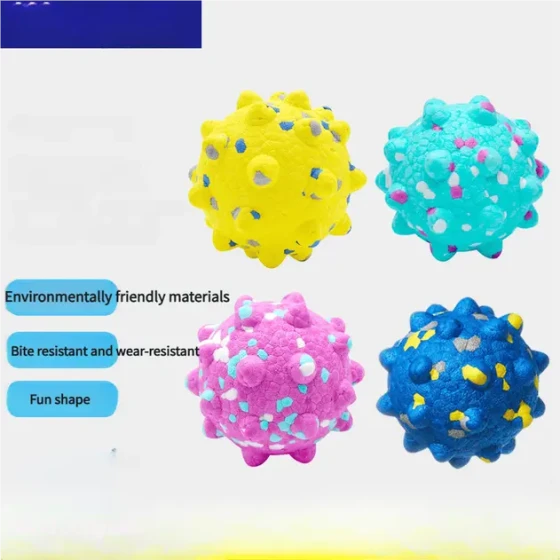Discharge in the eyes of newborn kittens_Reasons and care for newborn kittens with excessive eye discharge
Discharge appearing in the eyes of newborn kittens is usually a normal physiological phenomenon, a sign of mild irritation, or an infection. If the discharge is clear or light-colored and the kitten is in good spirits, it might be caused by the eyes just opening or environmental stimuli; however, if the discharge is yellow or green and thick, accompanied by eye redness and swelling, lethargy, or loss of appetite, it likely indicates bacterial, viral, or chlamydial infection such as conjunctivitis or upper respiratory infection, necessitating prompt veterinary care.

Newborn kittens, these tiny lives at birth, rely entirely on their mother’s care. When their little eyes first open curiously to explore the world, some owners might notice their eye corners are moist or have discharge, causing concern: “Oh no, what’s wrong with my kitten’s eyes?” Don’t worry, this might be normal or could be a sign needing attention. Today, let’s talk thoroughly about why newborn kittens have a lot of eye discharge.
Common causes of excessive eye discharge in newborn kittens: unraveling the secret of "tearful eyes"
There are many reasons for newborn kittens to have eye discharge, just like human babies sometimes cry when yawning or because they are sick.
- Physiological eye discharge: the "little surprise" when opening eyes
Kittens usually open their eyes between 7 to 14 days after birth, marking the moment they "open the door to a new world." During eyelid separation, the eyes might secrete some clear liquid, a normal physiological response helping the eyes adapt to the environment. This discharge is typically clear and minimal, with the kitten’s energy and appetite normal. Just like us waking up with a bit of eye discharge, this is quite ordinary. - Conjunctivitis: the kitten’s “little matchmaker” eye problem
Conjunctivitis is a common "culprit" leading to excessive eye discharge in kittens. It’s like draping a “red veil” over their eyes, making them uncomfortable.- Bacterial conjunctivitis: May result from unclean environments, infection in the mother’s birth canal, or weak kitten immunity. Discharge usually turns yellow or green and purulent, with redness, swelling, and eyelid sticking together, making it difficult to open the eyes, as if “sealed.”
- Viral conjunctivitis: Feline herpesvirus is one culprit, causing eye issues often alongside upper respiratory infection. Discharge initially clear but may become sticky.
- Chlamydial conjunctivitis: Another common infection with symptoms similar to bacterial conjunctivitis, featuring red swollen eyes and mucopurulent discharge.
- Upper respiratory infections (URIs): sneezing affecting the eyes?
You might wonder how respiratory infections affect eyes. Actually, a cat’s respiratory tract, mouth, and eyes are interconnected. When kittens suffer from feline herpesvirus or calicivirus infections, causing URIs, symptoms include sneezing, runny nose, increased eye discharge, eye redness, and tearing. It’s similar to humans having a cold where a blocked nose often causes watery eyes. - Tear duct blockage: tears with nowhere to go
Rarely, kittens may have developmental abnormalities or inflammatory blockage of tear ducts, causing tears to accumulate at the eye corners and form discharge. This is less common but worth considering when other causes are excluded. - Environmental irritants and hygiene issues: unseen "enemies"
Dust, irritating odors (like secondhand smoke or cleaners), or unclean litter boxes in the kitten’s environment can irritate their eyes causing tearing and discharge. If the mother cat’s cleaning is insufficient or living conditions are unhygienic, bacterial growth may lead to eye infections.
How to judge the severity of eye problems in kittens?
Eye discharge shouldn’t be wiped away casually; we need to "read the situation" to judge its urgency.
- Examine the color and texture of discharge:
- Clear or light-colored, watery: Mostly normal physiological reaction or minor irritation.
- White, sticky: Could indicate early viral infection or mild bacterial infection.
- Yellow or green purulent: A "red warning light," usually meaning serious bacterial infection requiring immediate veterinary attention.
- Dried crusts: If discharge dries thick with hard crusts preventing the kitten from opening eyes, the condition is quite serious and may require warm compresses to soften before cleaning.
- Check the extent of eye redness and swelling:
- Mild redness: Possibly minor irritation or inflammation.
- Obvious swelling, eyelid eversion or inversion: Indicates more serious inflammation needing timely intervention.
- Observe kitten’s state and accompanying symptoms:
- Energetic, normal appetite, no other symptoms: Likely a minor issue.
- Lethargic, poor appetite, sneezing, runny nose, rapid breathing: Suggests upper respiratory infection likely severe; seek veterinary care promptly.
Golden rules for kitten eye care: meticulous love
When caring for kitten eyes, treat them as fragile items with utmost care.
- Cleaning steps and tips: gentle is key
- Prepare tools: Ready clean cotton swabs or cotton pads, and boiled and cooled warm water (or pet-safe saline). Ensure water temperature is not too hot, ideally 37-38°C (98.6-100.4°F).
- Stable posture: Find a quiet comfortable place, gently hold the kitten or have someone assist in restraining to prevent sudden movement.
- Warm compress to soften: Moisten cotton swab or pad with warm water, gently apply to the eye with discharge for a few seconds to soften it.
- Wipe from inside to outside: Using moist cotton swabs or pads, wipe discharge from the inner corner near the nose outward. Avoid back-and-forth motion to prevent spreading bacteria. Use a fresh swab or pad each time.
- Keep dry: After cleaning, gently blot around the eye with a clean tissue or cotton pad to avoid moisture fostering bacteria.
- Cleaning frequency: based on condition
If discharge is minimal and clear, clean 1-2 times daily; if abundant or sticky, clean every few hours until improvement. - Precautions: better safe than sorry
- Never touch with bare hands directly: Wash hands thoroughly before cleaning to avoid transferring bacteria.
- Use dedicated tools: Always use clean, disposable cotton swabs or pads to avoid cross-infection.
- Avoid irritants: Do not use human eye drops or unknown liquids, as they may irritate delicate kitten eyes.
- Monitor changes: Watch carefully for new or worsening symptoms during cleaning; seek veterinary care when necessary.
When to seek immediate veterinary care?
If you notice any of the following, don’t hesitate to take your kitten to the vet immediately:
- Discharge is yellow or green and purulent, or the eyes are completely glued shut with discharge.
- Clear eye redness and swelling, pain, frequent scratching at the eyes, or squinting.
- One or both eyes fail to open for a prolonged time.
- Accompanied by systemic symptoms such as lethargy, poor appetite, difficulty breathing, persistent sneezing, runny nose, or fever.
- No improvement or worsening after 24-48 hours of home care.
Possible veterinary diagnosis and treatment: professional power
When you take your kitten to the vet, the doctor will conduct professional examinations, usually including:
- Eye examination: Observing eye symptoms and discharge condition.
- Ophthalmic staining test: Rule out corneal injury.
- Discharge sample testing: May collect eye discharge for bacterial culture or viral tests to clarify infection type.
- Full physical examination: Assess overall health of the kitten.
Depending on diagnosis, vets may apply following treatments:
- Local medication: For bacterial conjunctivitis, prescribe pet-specific antibiotic eye drops or ointments; for viral conjunctivitis, antiviral eye medication may be used.
- Oral medication: If caused by upper respiratory infection or severe infection, vets may prescribe oral antibiotics, antivirals, or supportive drugs.
- Artificial tears: Used when the eyes are dry or cornea is damaged to lubricate the eyes.
- Warm compresses: Vets may advise continuing warm compresses at home to soften discharge.
Always follow vet instructions strictly; do not stop or change dosage without guidance to avoid worsening or resistance.
Key to preventing eye problems in newborn kittens: prevention is better than cure
Prevention always beats treatment. Providing a healthy and comfortable environment is the best protection for kittens.
- Mother cat’s health management: Ensure the mother is healthy during pregnancy, regularly dewormed and vaccinated. A healthy mother provides better antibody protection for kittens.
- Environmental hygiene: Keep kittens’ living area clean, dry, and warm, avoiding dust, irritants, and dampness. Regularly clean and disinfect the cat nest.
- Balanced nutrition: Ensure both mother and kittens receive sufficient and balanced nutrition to boost immunity.
- Regular observation: Owners should carefully observe kittens’ eyes, nose, and spirit daily for early detection and treatment.
Common questions and answers
Q1: Is it normal for newborn kittens to have eye discharge before their eyes open?
A1: If the discharge is minimal and clear, it’s usually a normal physiological phenomenon, especially right before opening eyes. But if discharge is abundant, yellow, green, or accompanied by redness and swelling, even if the eyes haven’t opened, it may be infection requiring attention.
Q2: Can saline solution be used to clean kittens’ eyes?
A2: Yes. Sterile saline is gentle and safe for cleaning and softening eye discharge. Use pet-specific or medical-grade sterile saline.
Q3: Does excessive eye discharge always affect vision?
A3: Mild eye discharge generally does not affect vision. However, severe eye infections causing corneal ulcers or prolonged inflammation can cause permanent vision damage or blindness. Timely treatment is critical.
Q4: Can I buy medicine myself to treat kitten’s eye discharge?
A4: It’s not recommended to use human eye drops or medicines without veterinary guidance. Kitten eyes are very fragile; inappropriate drugs may cause irritation or worsen conditions. Always seek professional veterinary diagnosis and advice.
Summary
Eye discharge in newborn kittens is a common "minor episode" in their growth process. As responsible pet owners, we must stay calm, discern normal physiological responses from health issues, and master proper care techniques. When kittens show abnormal eye signs, prompt monitoring, correct cleaning, and decisive veterinary visits are the best love and protection we can offer. After all, whether their “bright fiery eyes” can see the world healthily depends on our meticulous care.
References:
- Merck Veterinary Manual, section on eye diseases in kittens.
- Articles on cat eye care from the American Society for the Prevention of Cruelty to Animals (ASPCA) official website.
- Professional veterinary textbooks such as "Small Animal Internal Medicine" discussing kitten diseases and ophthalmology.
- Cat health guides published by Cornell University Feline Health Center.




